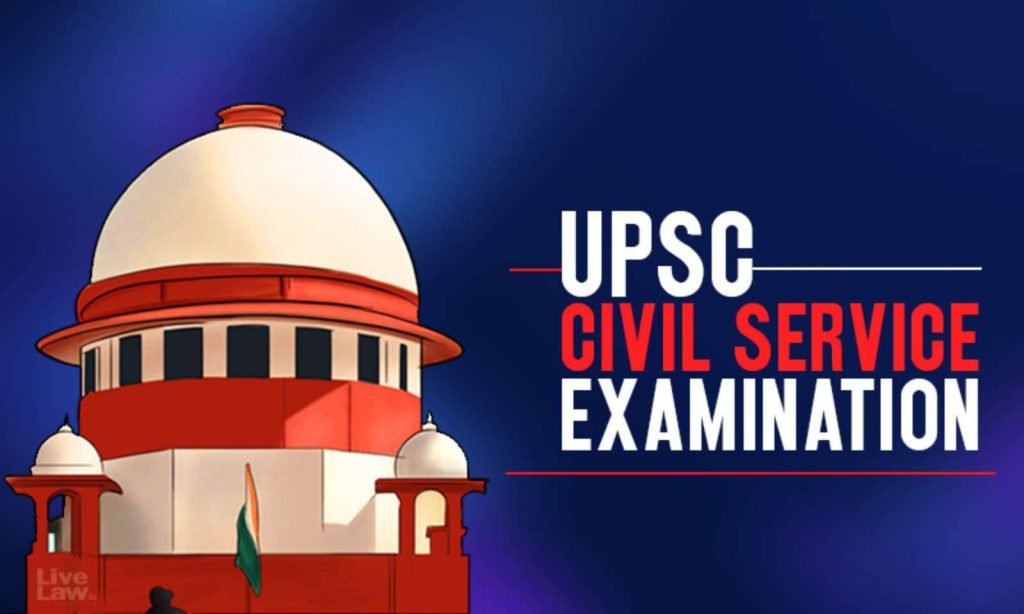About UPSC Examination :
What is the pattern and syllabus of this examination? This is the very first and the basic question for any beginner when he start his UPSC Journey. It is important for any individual to thoroughly understand the exam requirement and then proceed with his/her preparation. This article is aimed to draw insights and help aspirants gain clarity in understanding the process of the exam. Commonly known as UPSC Exam or IAS Exam, the UPSC Civil Services Examination (CSE) is the examinations conducted by the Union Public Service Commission to recruit candidates into civil services of India. The examination is conducted in three phases namely UPSC CS Preliminary Examination or UPSC Prelims, UPSC CS Main Examination or UPSC Main, and the personality Test or UPSC Interview. UPSC Preliminary Examination is the screening test and thus is qualifying in nature. The score obtained in the Prelims exam is not calculated for the final merit. It consists of two papers that are objective-type MCQ-based as opposed to the UPSC Civil Services Mains Exam. The UPSC Mains Exam is a descriptive-exam consisting of nine papers. In this article, we will discuss the UPSC exam syllabus, pattern, and other important details. Pattern of civil services exam is like this….
Stage 1- Preliminary Exam
Stage 2 -Mains Exam
Stage 3- Interview also known as Personality Test.
Preliminary exam consist of two objective type papers of 200 marks each with 2 hours duration.
| Exam | Number of Questions | Nature of paper |
| Paper I | 100 | Merit based
|
| Paper II (CSAT) | 80 | Qualifying in nature |
Mains exam The written examination consists of 9 papers of 3 hours duration out of which 2 papers are only of qualifying nature. The marks obtained in the remaining 7 papers and the interview test together are counted in the final merit list.
| Paper Name | Total Marks | Nature of paper |
| Paper A – Compulsory Indian Language | 300 | Qualifying type |
| Paper B- Compulsory English language | 300 | Qualifying type |
| Paper I – Essay | 250 | Considered for merit
|
| Paper II- General studies 1 | 250 | Merit based
|
| Paper III- General studies paper 2 | 250 | Merit based |
| Paper IV- General studies paper 3 | 250 | Merit based |
| Paper V- General studies paper 4 | 250 | Merit based
|
| Paper VI- Optional paper 1 | 250 | Merit based |
| Paper VII- Optional paper 2 | 250 | Merit based
|
| Total 1750 | ||
| Interview /personality test | 275 | |
| Grand total 2025 |

UPSC Exam Syllabus:
UPSC has an extensive exam syllabus for the papers included in UPSC Prelims and UPSC Mains. Proper knowledge and the pattern of questions would help the candidates earn good standing.
IAS Prelims Syllabus :
- General Studies Paper I
- Current events of national and international importance.
- History of India and Indian National Movement.
- Indian and World Geography-Physical, Social, Economic Geography of India and the World.
- Indian Polity and Governance-Constitution, Political System, Panchayati Raj, Public Policy, Rights Issues, etc.
- Economic and Social Development-Sustainable Development, Poverty, Inclusion, Demographics, Social Sector Initiatives, etc.
- General issues on environmental ecology, biodiversity and Climate Change – that do not require subject specialization.
- General science
- General Studies Paper-II (CSAT)
- Comprehension
- Interpersonal skills including communication skills
- Logical reasoning and analytical ability
- Decision making and problem-solving
- General mental ability
- Basic numeracy (numbers and their relations, orders of magnitude, etc.)(Class X level), Data interpretation (charts, graphs, tables, data sufficiency, etc. — Class X level)
UPSC MAINS SYLLABUS IAS Syllabus :
A) General Studies Paper-I :
- Indian Heritage and Culture, History and Geography of the World and Society. (Topic & depth of knowledge required for history & present policy)
- Indian culture will cover the salient aspects of Art Forms, literature and Architecture from ancient to modern times.
- Modern Indian history from about the middle of the eighteenth century until the present- significant events, personalities, issues.
- The Freedom Struggle — its various stages and important contributors/contributions from different parts of the country.
- Post-independence consolidation and reorganization within the country.
- History of the world will include events from the 18th century such as the industrial revolution, world wars, re-drawal of national boundaries, colonization, decolonization, political philosophies like communism, capitalism, socialism etc.— their forms and effect on the society.
- Salient features of Indian Society, Diversity of India.
- Role of women and women’s organization, population and associated issues, poverty and developmental issues, urbanization, their problems and their remedies.
- Effects of globalization on Indian society.
- Social empowerment, communalism, regionalism & secularism.
- Salient features of the world’s physical geography.
- Distribution of key natural resources across the world (including South Asia and the Indian sub-continent); factors responsible for the location of primary, secondary, and tertiary sector industries in various parts of the world (including India).
- Important Geophysical phenomena such as earthquakes, Tsunami, Volcanic activity, cyclone etc., geographical features and their location-changes in critical geographical features (including water-bodies and ice-caps) and in flora and fauna and the effects of such changes.
B) General Studies Paper-II :
- Governance, Constitution, Polity, Social Justice and International relations. (aim is to that in depth knowledge of our country’s basic administrative fabric)
- Indian Constitution—historical underpinnings, evolution, features, amendments, significant provisions and basic structure.
- Functions and responsibilities of the Union and the States, issues and challenges pertaining to the federal structure, devolution of powers and finances up to local levels and challenges therein.
- Separation of powers between various organs, dispute redressal mechanisms and institutions.
- Government strives to have a workforce which reflects gender balance and women candidates are encouraged to apply.
- Comparison of the Indian constitutional scheme with that of other countries.
- Parliament and State legislatures—structure, functioning, the conduct of business, powers & privileges and issues arising out of these.
- Structure, organization and functioning of the Executive and the Judiciary—Ministries and Departments of the Government; pressure groups and formal/informal associations and their role in the Polity.
- Appointment to various Constitutional posts, powers, functions and responsibilities of various Constitutional Bodies. Statutory, regulatory and various quasi-judicial bodies.
- Government policies and interventions for development in various sectors and issues arising out of their design and implementation.
- Development processes and the development industry —the role of NGOs, SHGs, various groups and associations, donors, charities, institutional and other stakeholders.
- Welfare schemes for vulnerable sections of the population by the Centre and States and the performance of these schemes; mechanisms, laws, institutions and Bodies constituted for the protection and betterment of these vulnerable sections.
- Issues relating to the development and management of Social Sector/Services relating to Health, Education, Human Resources. Issues relating to poverty and hunger.
- Important aspects of governance, transparency and accountability, e-governance applications, models, successes, limitations, and potential; citizens charters, transparency & accountability and institutional and other measures.
- Role of civil services in a democracy.
- India and its neighbourhood- relations.
- Bilateral, regional and global groupings and agreements involving India and/or affecting India’s interests.
- Effect of policies and politics of developed and developing countries on India’s interests, Indian diaspora.
- Important International institutions, agencies and fora- their structure, mandate.
Syllabus General Studies:
Paper III (Covers macro syllabus economics, IT & environment related laws & issues)
- Technology, Economic Development, Biodiversity, Environment, Security and Disaster Management
- Indian Economy and issues relating to planning, mobilization, of resources, growth, development and employment.
- Inclusive growth and issues arising from it.
- Government Budgeting.
- Major crops-cropping patterns in various parts of the country, different types of irrigation and irrigation systems storage, transport and marketing of agricultural produce and issues and related constraints; e-technology in the aid of farmers.
- Issues related to direct and indirect farm subsidies and minimum support prices; Public Distribution System- objectives, functioning, limitations, revamping; issues of buffer stocks and food security; Technology missions; economics of animal-rearing.
- Food processing and related industries in India- scope’ and significance, location, upstream and downstream requirements, supply chain management.
- Land reforms in India.
- Effects of liberalization on the economy, changes in industrial policy and their effects on industrial growth.
- Infrastructure: Energy, Ports, Roads, Airports, Railways etc.
- Investment models.
- Science and technology- developments and their applications and effects in everyday life.
- Achievements of Indians in science & technology; indigenization of technology and developing new technology.
- Awareness in the fields of IT, Space, Computers, robotics, nano-technology, bio-technology and issues relating to intellectual property rights.
- Conservation, environmental pollution and degradation, environmental impact assessment.
- Disaster and disaster management.
- Linkages between development and spread of extremism.
- Role of external state and non-state actors in creating challenges to internal security.
- Challenges to internal security through communication networks, the role of media and social networking sites in internal security challenges, basics of cybersecurity; money laundering and its prevention.
- Security challenges and their management in border areas – linkages of organized crime with terrorism.
- Various Security forces and agencies and their mandate.
Ethics Syllabus:
Ethics, Integrity and Aptitude: (Very important in present context)
This paper will include questions to test the candidates’ attitude and approach to issues relating to integrity, probity in public life and his problem-solving approach to various issues and conflicts faced by him in dealing with society. Questions may utilize the case study approach to determine these aspects. The following broad areas will be covered : Ethics and Human Interface: Essence, determinants and consequences of Ethics in-human actions; dimensions of ethics; ethics – in private and public relationships. Human Values – lessons from the lives and teachings of great leaders, reformers and administrators; the role of family society and educational institutions in inculcating values.
Attitude: content, structure, function; its influence and relation with thought and behaviour; moral and political attitudes; social influence and persuasion.
- Aptitude and foundational values for Civil Service, integrity, impartiality and non partisanship, objectivity, dedication to public service, empathy, tolerance and compassion towards the weaker sections.
- Emotional intelligence-concepts, and their utilities and application in administration and governance.
- Contributions of moral thinkers and philosophers from India and the world.
- Public/Civil service values and Ethics in Public administration: Status and problems; ethical concerns and dilemmas in government and private institutions; laws, rules, regulations and conscience as sources of ethical guidance; accountability and ethical governance; strengthening of ethical and moral values in governance; ethical issues in international relations and funding; corporate governance.
- Probity in Governance: Concept of public service; Philosophical basis of governance and probity; Information sharing and transparency in government, Right to Information, Codes of Ethics, Codes of Conduct, Citizen’s Charters, Work culture, Quality of service delivery, Utilization of public funds, challenges of corruption.
- Case Studies on the above issues.

Quitters Don’t Win and Winners Don’t Quit.
Ironman | Deccan Cliffhanger | Comrade Legend Finisher | Motivational Speaker | Writer | Endurance Athlete






10 comments
Thank you sir…I am ur big fan and I watch all posts on instagram..Monday and thusday is best motivational day because of ur post…
Thanks Akshayraje.
Mujhe upsc ki class join KRni h Hindi me
Nikhil, mere pas iske bare mei koi jyada information nahi hai
Hello sir,
Do you provide mentorship I wanted to speak to you
Ayush, I don’t have that much time because of my job. If you have any specific question then we can always discus that.
Very useful one sir this what you have posted
Thanks
Hii
Hello Nikhil